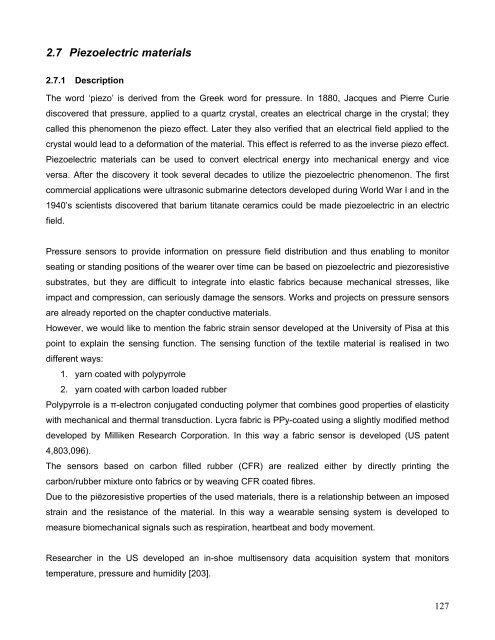Clevertex - Grado Zero Espace Srl
Clevertex - Grado Zero Espace Srl
Clevertex - Grado Zero Espace Srl
You also want an ePaper? Increase the reach of your titles
YUMPU automatically turns print PDFs into web optimized ePapers that Google loves.
2.7 Piezoelectric materials<br />
2.7.1 Description<br />
The word ‘piezo’ is derived from the Greek word for pressure. In 1880, Jacques and Pierre Curie<br />
discovered that pressure, applied to a quartz crystal, creates an electrical charge in the crystal; they<br />
called this phenomenon the piezo effect. Later they also verified that an electrical field applied to the<br />
crystal would lead to a deformation of the material. This effect is referred to as the inverse piezo effect.<br />
Piezoelectric materials can be used to convert electrical energy into mechanical energy and vice<br />
versa. After the discovery it took several decades to utilize the piezoelectric phenomenon. The first<br />
commercial applications were ultrasonic submarine detectors developed during World War I and in the<br />
1940’s scientists discovered that barium titanate ceramics could be made piezoelectric in an electric<br />
field.<br />
Pressure sensors to provide information on pressure field distribution and thus enabling to monitor<br />
seating or standing positions of the wearer over time can be based on piezoelectric and piezoresistive<br />
substrates, but they are difficult to integrate into elastic fabrics because mechanical stresses, like<br />
impact and compression, can seriously damage the sensors. Works and projects on pressure sensors<br />
are already reported on the chapter conductive materials.<br />
However, we would like to mention the fabric strain sensor developed at the University of Pisa at this<br />
point to explain the sensing function. The sensing function of the textile material is realised in two<br />
different ways:<br />
1. yarn coated with polypyrrole<br />
2. yarn coated with carbon loaded rubber<br />
Polypyrrole is a π-electron conjugated conducting polymer that combines good properties of elasticity<br />
with mechanical and thermal transduction. Lycra fabric is PPy-coated using a slightly modified method<br />
developed by Milliken Research Corporation. In this way a fabric sensor is developed (US patent<br />
4,803,096).<br />
The sensors based on carbon filled rubber (CFR) are realized either by directly printing the<br />
carbon/rubber mixture onto fabrics or by weaving CFR coated fibres.<br />
Due to the piëzoresistive properties of the used materials, there is a relationship between an imposed<br />
strain and the resistance of the material. In this way a wearable sensing system is developed to<br />
measure biomechanical signals such as respiration, heartbeat and body movement.<br />
Researcher in the US developed an in-shoe multisensory data acquisition system that monitors<br />
temperature, pressure and humidity [203].<br />
127

















